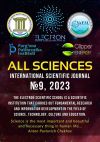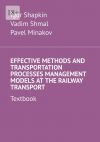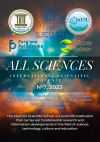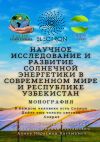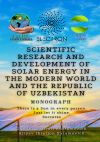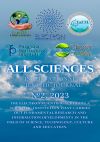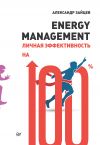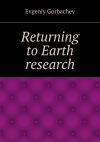Текст книги "All sciences. №1, 2022. International Scientific Journal"
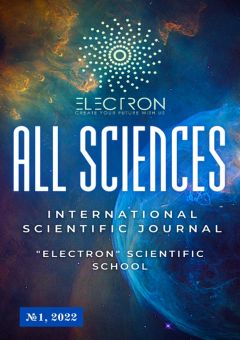
Автор книги: Ibratjon Aliyev
Жанр: Медицина, Наука и Образование
Возрастные ограничения: +12
сообщить о неприемлемом содержимом
Текущая страница: 1 (всего у книги 2 страниц)
All sciences. №1, 2022
International Scientific Journal
Authors: Aliyev Ibratjon Xatamovich, Karimov Boxodir Xoshimovich, Sharofutdinov Farruh Murodjonovich, Aripova Sayyora Boxodirovna, Burnashev Marat Albertovich, Karimov Shavkat Boxodirovich, Yuldoshaliyev Dilshod Quldoshaliyevich, Vavilova Ekaterina Aleksandrovna, Umarova Gulnoza Masxariddinovna, Karimova Dilfuza Boxodirovna, Nazirova Dilyafruz Baxtiyarovna, Abduraxmonov Sultonali Mukaramovich, Jalolov Botirali Rustamovich
Editor-in-Chief, responsible for the issue of the journal, founder and CEO of the Electron Organization and President of the Electron Scientific School Ibratjon Xatamovich Aliyev
Editor, Candidate of Physical and Mathematical Sciences, Associate Professor of the Faculty of Physics and Technology of Fergana State University, responsible for the final moderation and review of articles, editor, scientific supervisor of the Electron project Boxodir Xoshimovich Karimov
Editor, Economics Professor of the Electron Scientific School, candidate in the field of economics, editor, economic consultant of the Electron project, owner of the Clipper Energy company Botirali Rustamovich Jalolov
Editor, candidate in the field of astrological, philosophical and pedagogical sciences, moderator Xolidaxon Tulkinovna Aliyeva
Editor, Chief Scientific Secretary of the Electron Scientific School, candidate in the field of economic sciences, editor, economic manager of the Electron project Farruh Murodjonovich Sharofutdinov
Responsible for primary moderation, editing of articles Marat Albertovich Burnashev
Editor, Doctor of Technical Sciences, Associate Professor of the Research Institute of Semiconductors and Microelectronics at the National University of Uzbekistan Obbozxon Xokimovich Qo'ldoshev
Editor, Senior Researcher, Head of the Laboratory of Accelerator Technology at the Research Institute of Semiconductors and Microelectronics at the National University of Uzbekistan Rinad Fuadovich Rumi
Editor, Doctor of Physical and Mathematical Sciences, Professor of the Laboratory of Accelerator Technology at the Research Institute of Semiconductors and Microelectronics at the National University of Uzbekistan Isabek Xolbayevich Xolbayev
Editor, Doctor of Physical and Mathematical Sciences, Professor of the Faculty of Physics and Technology of Ferghana State University Slim Madraximovich Otajonov
Editor, Doctor of Philosophy in Technical Sciences (PhD), Associate Professor of the Faculty of Physics and Technology of Fergana State University Sharof Shuxratovich Shuxratov
Editor, Candidate of Physical and Mathematical Sciences, Dean of the Faculty of Mathematics and Computer Science of Fergana State University Ibroximjon Usmonaliyevich Xaydarov
Editor, Candidate of Physical and Mathematical Sciences, Associate Professor of the Faculty of Computer Design Systems of the Fergana Polytechnic Institute Sultonali Mukaramovich Aduraxmonov
Editor, Candidate of Technical Sciences, Associate Professor of the Faculty of Physics and Technology of Fergana State University Yakub Usmonovich Usmonov
Editor, Candidate of Biological Sciences, Associate Professor of the Faculty of Natural Sciences of Ferghana State University Muzaffar Avliyaxonovich Muxammadiyev
Editor, Candidate of Pedagogical Sciences, Associate Professor of the Department of «Information and Educational Technologies» of the Fergana branch of TUIT named after Muhammad al-Harezmi Inomjon Uktamovich Bilolov
Editor, Candidate of Physical and Mathematical Sciences, Associate Professor of the Department of Information Technologies of Fergana State University Tohir Xalimovich Tojiyev
Editor, Doctor of Philosophy in Physical and Mathematical Sciences, Senior Lecturer at the Faculty of Physics and Technology of Ferghana State University Sapura Malikovna Zaynolobidinova
Editor, Lecturer at the Faculty of Physics and Technology of Fergana State University Dilshod Quldoshaliyevich Yuldoshaliyev
Editor, Lecturer at the Faculty of Mathematics and Computer Science of Fergana State University Olimxon Ulugbekovich Axmedov
Editor, Lecturer at the Faculty of Mathematics and Computer Science of Fergana State University Sayyora Saidakbarovna Kukiyeva
Editor, Lecturer at the Faculty of Mathematics and Computer Science of Fergana State University Nargiza Saidakbarovna Ikromova
Editor, Lecturer at the Faculty of Physics and Technology of Fergana State University Nodir Esonaliyevich Alimov
Editor, Lecturer at the Faculty of Physics and Technology of Fergana State University Axliddin Mirzoxidovich Kuchkarov
Illustrator Ibratjon Xatamovich Aliyev
Illustrator Axliddin Mirzoxidovich Kuchkarov
Cover design Ibraton Xatamovich Alyev
Cover design Boxodir Xoshimovich Karimov
Proofreader Ibratjon Xatamovich Aliyev
Proofreader Boxodir Xoshimovich Karimov
© Ibratjon Xatamovich Aliyev, 2022
© Boxodir Xoshimovich Karimov, 2022
© Farruh Murodjonovich Sharofutdinov, 2022
© Sayyora Boxodirovna Aripova, 2022
© Marat Albertovich Burnashev, 2022
© Shavkat Boxodirovich Karimov, 2022
© Dilshod Quldoshaliyevich Yuldoshaliyev, 2022
© Ekaterina Aleksandrovna Vavilova, 2022
© Gulnoza Masxariddinovna Umarova, 2022
© Dilfuza Boxodirovna Karimova, 2022
© Dilyafruz Baxtiyarovna Nazirova, 2022
© Sultonali Mukaramovich Abduraxmonov, 2022
© Botirali Rustamovich Jalolov, 2022
ISBN 978-5-0059-3166-5 (т. 1)
ISBN 978-5-0059-3167-2
Created with Ridero smart publishing system
PHYSICAL AND MATHEMATICAL SCIENCES
ABOUT ONE HEURISTIC IDEA ABOUT THE EMERGENCE OF A NEW ENERGY TECHNOLOGY FOR OBTAINING ENERGY FROM RESONANT NUCLEAR REACTIONS
Aliev Ibratjon Khatamovich, 1st year student of the Faculty of Mathematics and Computer ScienceFerghana State University, Uzbekistan
E-mail: ibratjon25@mail.ru
I don’t think that the same excitement can pass through the human heart that an inventor feels when watching how successfully the creation of the brain works.
Nikola Tesla
Annotation. Energy has been important for all mankind since ancient times. Every day a person consumes more and more energy, and if earlier the main source of energy was fire, today its role is increasingly being performed by electric current. With the help of electricity, lamps are lit, computers work, books are printed, food is heated and cars are already driving. Electricity has entered into all corners of human life and is the most important resource, it is for this reason that a person has been looking for a variety of ways to extract electrical energy and, although a variety of varieties have already been found, but today we can safely talk about the best option among them, namely, obtaining energy from resonant nuclear reactions.
Keywords: charged particle accelerator, electric energy, high efficiency of electricity generation, nuclear reaction cross section.
Аннотация. Энергия важна для всего человечества ещё с древних времён. С каждым днём человек потребляет всё больше и больше энергии, и если раньше основным источником энергии был огонь, то сегодня его роль всё чаще начинает выполнять электрический ток. При помощи электричества зажигаются лампы, работают компьютеры, печатаются книги, греется пища и уже ездят машины. Электричество вошло во все уголки жизнедеятельности человека и является важнейшим ресурсом, именно по этой причине человек искал самые различные пути для добычи электрической энергии и, хотя уже были найдены самые различные разновидности, но сегодня можно смело говорить о самом лучшем варианте среди них, а именно о получении энергии из резонансных ядерных реакций.
Ключевые слова: ускоритель заряженных частиц, электрическая энергия, высокая эффективность генерации электричества, сечение ядерной реакции.
For the first time, work on the generation of electric current began with experiments on the study of electromagnetic induction by Michael Faraday, but for a long time these works were not implemented in the face of industrial plants and installations. Initially, only steam engines were used to perform certain work by James Watt, and only after the invention of the armature winding of dynamoelectric machines by the Belgian Zenob Theophil Gram in 1871, it became possible to obtain electric current industrially.

Fig. 1. Three-dimensional model of the Electron device
Thus, the first power station was a hydroelectric power station, created in 1878 by an English engineer, Baron William Armstrong at his estate Cragside, in England. The generated electricity was used for lighting, heating, hot water supply and other household work.
But for the people and all mankind, electricity began to serve only 4 years later, in the winter of January 12, 1882, in London, when the world’s first public coal-fired electric power station by Thomas Edison, built according to his own project, started working. Since then, mankind has been industrially using electric current.
To date, to generate electric current and meet the needs of mankind in this resource, technologies for generating electric energy from heat (steam pressure) are used, which is clearly expressed in the technologies of thermal power plants (thermal power plants), other projects such as nuclear power plants (nuclear energy), wind power plants (wind energy), hydroelectric power plants (water energy) are also considered popular.), BSU (biogas plants) and others.
Analyzing the above facts, it becomes clear that a development is needed that can generate electric current with greater efficiency, on a larger scale, and also more safely than with the help of technologies used today. And if we consider all possible ways of obtaining electrical energy, then there is an explanation for why this study, which has been going on for more than 5 years, was so called – “Electron”.
It is in this way that a full-fledged idea, a separate idea, is formed and rises right in front of the reader, which is of enormous importance for all mankind, ensuring the generation of electric energy on a huge scale, buildings will become easier and faster compared to other electric power stations, however, as well as the costs of their construction. At the same time, the possibility of providing electric current to the entire population will increase. The energy and information hunger will disappear, it will be possible not to be afraid of large losses in wires and to increase the transition to the transmission of electrical energy without wires, as Nikola Tesla predicted back in the 1900s.
The number of various experiments conducted in various research institutes, which are now waiting for the latest source of electrical energy, will increase. A person will be able to extend the time of his stay in space several times and may even take a swing at seemingly insane ideas about creating artificial atoms from electrical energy. At the same time, the number of various assumptions and riddles that will be reflected in the works of science fiction writers and writers will increase. The whole human world will sway and begin to move with leaps and bounds and a great future will come.
But in order to realize all this, you need to take the first step, namely, to enter into the depths of the Electron research.
Bibliographic list1. Aliev I. H., Sharafutdinov F. M. The use of accelerators and the phenomena of collisions of elementary particles with high-order energy to generate electrical energy. The Electron Project: A monograph. Publishing solutions. Reader, 2021. – 594 p.
2. Aliyev I. H., Karimov B. H. Linear electron accelerator in power engineering // Exact science. – 2020. – No.85. – pp. 23—29.
3. Aliyev I. H. Behavior of an electron in an atom // Exact science. – 2019. – No. 63. – pp. 23—29.
GENERAL PRESENTATION OF THE LCA-EPD-20 ACCELERATOR
Boxodir Xoshimovich Karimov, Candidate of Physical and Mathematical Sciences, Associate Professor of the Faculty of Physics and Technology of Fergana State UniversityFerghana State University, Uzbekistan
E-mail: b_karimov48@mail.ru
Annotation. Since the necessary research was carried out in the field of searching for such a source and method of energy generation, nuclear reactions were finally recognized as a solution that would increase their own cross-section, therefore, both the probability of passing the reaction itself and the number of active reactions, which of course is directly related to the overall efficiency of the entire nuclear reaction. What follows when taking into account that the energy of the flying particles from the nuclear reaction, in the entire tuple of particles, is the total voltage, and the number of flying particles, due to their charge, creates a parameter of the current strength of the system. Then, as a consequence of this, it is possible to identify the need to create a special accelerator LCC-ED-20, for carrying out the above-mentioned nuclear reactions.
Keywords: science, research, resonant nuclear reactions, physics of the atomic nucleus and elementary particles.
Аннотация. Поскольку проводились необходимые исследования в области поиска подобного источника и метода генерации энергии, то наконец решением были признаны ядерные реакции, которые бы увеличивали собственное сечение, следовательно, как вероятность прохождения самой реакции, так и количество действовавших реакций, что конечно же напрямую связано с общей эффективностью всей ядерной реакции. Что вытекает при учёте, что энергия вылетающих частиц из ядерной реакции, во всём картеже частиц, это общее напряжение, а количество вылетающих частиц, благодаря их заряду создаёт параметр силы тока системы. То, как следствие из этого можно выявить необходимость создания специального ускорителя ЛЦУ-ЭПД-20, для проведения вышеуказанных ядерных реакций.
Ключевые слова: наука, исследование, резонансные ядерные реакции, физика атомного ядра и элементарных частиц.

Fig. 1. Three-dimensional model of the accelerator LCA-EPD-20
Due to the fact that the energies are selected in such a way that after passing the Coulomb barrier, the particle has an energy equal to the energy of its thermal counterpart and this fact alone increases the effective cross-section of the entire nuclear reaction into which the particle enters, then such nuclear reactions can be called resonant, due to the fact that they cause resonance in the system and only this increase the overall efficiency of the entire process.
Resonant nuclear reactions were first discovered in September 2021, after which active research was carried out, which led to a number of publications, the most significant of which was made in December 2021, which is the monograph of Aliyev I. H. and Sharofutdinova F. M. “The use of accelerators and phenomena of collisions of elementary particles with high-order energy for generating electric energy. The Electron Project”, which led to research in the field of searching for this method for 12 years, taking into account that the search in the field of atomic nucleus and elementary particle physics, as well as quantum physics, took place for a significant 5 years. The name of resonant nuclear reactions was given to these systems in January 2022 by Karimov Bokhodir Khoshimovich and appeared for the first time in this research.
Due to the fact that the relevance of resonant nuclear reactions quickly follows from the above, it remains to prove the relevance of the fact that a charged particle accelerator, a special type of LCA (Linear Cyclotron Accelerator), its class EPD-20, is necessary for the implementation of these nuclear reactions, it follows from the parameters that proton and deuterium beams are beams in it the Electron project with an energy of up to 20 MeV. Due to the fact that the energy must be selected, for example, for a conventional nuclear lithium-6 bombardment reaction with the release of two alpha particles, it is necessary to have a proton with an energy of 1.613245483 MeV, and only in this case it will be assumed that the final energy of the proton, after passing the Coulomb barrier at the nuclear radius, will be 0.25 eV, thanks to what does a proton become, what is called “thermal” and the effective cross-section of this nuclear reaction is already measured in huge units – kBn.
But today there is no LCC class accelerator on the whole planet, not to mention a detailed type of accelerators, having a common LCA-EPD-20 encoding, which could give a proton energy equal to 2,312691131 MeV for the first resonant nuclear reaction during the implementation of the Electron project, 1,978142789 MeV for the second resonant energy, 1,613245483 MeV for the third and 4.457595117 MeV for the fourth reaction, not because this energy is not achievable, by no means, this energy is scanty in accelerator physics, since modern particle accelerators appear with energies in GeV and TeV. The reason for the difficulty of achieving such results is precisely accuracy, accelerators can impart energy of 1 MeV, 1.5 MeV or 2 MeV, that is, specific values whose accuracy does not exceed 1 or 2 orders of magnitude, and as can be seen from calculations in an early monograph, much greater accuracy is needed to carry out these resonant nuclear reactions, which and it will be provided in the new LCA-EPD-20 accelerator of the Electron project.
Bibliographic list1. Aliev I. H., Sharafutdinov F. M. The use of accelerators and the phenomena of collisions of elementary particles with high-order energy to generate electrical energy. The Electron Project: A monograph. Publishing solutions. Reader, 2021. – 594 p.
2. Aliev I. H. New parameters for nuclear reactions to be carried out on an accelerator of charged particles of the LCC-EP-300 type. The Electron Project: A monograph. Publishing solutions. Reader, 2022. – 498 p.
3. Aliyev I. H. Software modeling of nuclear reaction phenomena based on technologies for creating a set of data using a system of algorithms in C++. The Core-COMPUTER project: A monograph. Publishing solutions. Reader, 2022. – 156 p.
IMPLEMENTATION AND SCIENTIFIC PUBLICATIONS ON THE ELECTRON PROJECT
Zhalolov Botirali Rustamovich, owner of the Malaysian company “Clipper Energy”, candidate in the field of economic sciencesFerghana State University, Uzbekistan; Electron Organization, Slipper Energy, Malaysia
Annotation. More than once it was mentioned about the project known as “Electron”, which was aimed at carrying out resonant nuclear reactions and obtaining energy from them. Speaking about the novelty of this project, along with a lot of points, which in this case are only partially given, it is important to clarify the fact that the feature of the accelerator being created for the research laboratory under the LCC-EPD-20 Electron project is accuracy. It is the ability to give duants a certain voltage, that when passing through the slits of the electric field, where the beam is accelerated, it is accelerated only by a certain number, which is only a part of the final energy.
Keywords: Electron project, accelerator for giving resonant energy, resonant nuclear reactions, physical and mathematical modeling.
Аннотация. Не раз упоминалось о проекте, известный под названием “Электрон”, который был направлен на осуществление резонансных ядерных реакций и получение из них энергии. Говоря о новизне этого проекта, наряду с множеством пунктов, которые в данном случае приводятся лишь частично, важно уточнить тот факт, что особенностью ускорителя, создаваемого для научно-исследовательской лаборатории при проекте “Электрон” ЛЦУ-ЭПД-20 является точность. Именно возможность придавать дуантам определённое напряжение, что при проходе через щели электрического поля, где и осуществляется ускорение пучка, ускоряется только на некоторое число, которая является лишь частью конечной энергии.
Ключевые слова: проект “Электрон”, ускоритель для придачи резонансной энергии, резонансные ядерные реакции, физико-математическое моделирование.
Of course, each study has its own results and stages of implementation, and the results of the ongoing research on the Electron project (Fig. 1) are published in scientific articles in the international journals “Exact Science”, “Young Scientist” and some others.
But of course, such a voluminous work would simply be impossible to describe in one general scientific work, this would lead to the fact that it would have titanic dimensions. Therefore, the general text is divided into several separate works, among which two works are already available. Speaking of these monographs, it is worth starting from those already published to date:
1. Aliev I. H., Sharofutdinov F. M. The use of accelerators and the phenomena of collisions of elementary particles with high-order energy to generate electrical energy. The Electron project is the first monograph published in this class and described the method of calculating and analyzing resonant nuclear reactions, while using high currents and power, only a superficial calculation of the consumption system was given, and at the end the first calculation mechanisms are given, but even though the study was mainly theoretical, it was this work sets all the necessary and used in the mechanism of the mathematical apparatus of the system;
2. Aliyev I. H. Software modeling of nuclear reaction phenomena based on the technology of creating a set of data using a system of algorithms in C++. The Core-Computer project is the second monograph that already describes the simplest model of a calculation system with resonant nuclear reactions, but already using C++ programming languages, which creates the opportunity to work at the simplest level, and then the transition to a more complex degree of work, at the same time showing the mathematical apparatus of resonant nuclear reactions;
3. New parameters for nuclear reactions to be carried out on a charged particle accelerator of the LCA-EPD-300 type. The Electron project – monograph is aimed at deriving the necessary data on resonant nuclear reactions, where integer data are as close as possible to real ones, much attention should be paid to lowering the current and approaching the actual values, which led to the fact that in the monograph, according to the general scheme, a station generating a power of about 12.68 GWh of electrical energy is described.

Fig. 1. The logo of the Organization “Electron” and the Scientific School “Electron”
Now, new monographs are to be published, but with a detailed description of this system, which includes this work. By listing the following, you can create the following list:
1. External data for the accelerator type LCA-EPD-20;
2. Physical description of the acceleration system of the LCA-EPD-20 type accelerator;
3. LCA-EPD-20 accelerator control system;
4. The energy mechanism for the accelerator type LCA-EPD-20.
Thus, each stage of work is quite important, and after the entire Electron project, it is possible to achieve the implementation of a grandiose work that opens up new opportunities, makes the whole state completely energy independent, because these 12.98 GWh of electric energy is more than enough to provide the entire Republic of Uzbekistan by 137.26%, thanks to which a new the infrastructure industry, which is the direction of energy exports from the state, which will also lead to the improvement and development of the state economy, not only in the industrial sense, but also in the real scientific sense!
